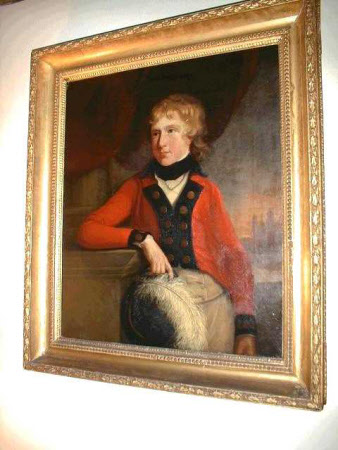The Hon. William Cust (1787-1845)
The Hon. Elizabeth Cust (1776 - 1858)
Category
Art / Oil paintings
Date
1805 (monogrammed and dated)
Materials
Oil on canvas
Measurements
950 x 830 mm
Place of origin
England
Order this imageCollection
Belton House, Lincolnshire
NT 436085
Summary
Oil painting on canvas, The Hon William Cust (1787-1845) by the Hon. Elizabeth Cust (1776-1858), signed with monogram, 1805. The artist was the elder sister of the sitter. A three-quarter length portrait of a young boy, facing, his head turned slightly to the left, gazing to the left, leaning on a stone plinth with his right arm and holding a white-plumed hat in his right hand, he is in the dress of a Salt bearer at the Eton Montem of 1805, composed of a scarlet jacket with black braid down the front with gilt buttons and a black stock. He has short blond curly hair. Eton College can be seen beyond on the right. Born on 23 January 1787, he was the son of Brownlow Cust, 1st Baron Brownlow of Belton (1744-1807) and Frances Bankes (1756-1847). He married Sophia Newnham (c.1790-1884), daughter of Thomas Newnham, on 8 July 1819. He was educated at Eton and became a barrister and Commissioner of Customs. The children of Hon. William Cust and Sophia Newnham were Captain William Purey Cust (1821-1865), The Very Reverend Arthur Perceval Purey-Cust (1828-1916). He died on 3 March 1845 at aged 58. Eton Montem (or ad Montem - literally to the Mountain) was a custom observed by Eton College from at least 1561 until it was finally suppressed in 1847, at the Montem Mound (or Salt Hill) in Chalvey, Slough, Buckinghamshire (later Berkshire). Montem is first reported in William Malim's Consuetudinarium (book of customs) of 1561, when it seems to have been an initiation ceremony for new boys, who were scattered with salt (which can mean 'wit' as well as 'salt') at the mound. By the 18th century, the ceremony had changed to a glorified flag day where money was collected as a contribution towards the University expenses of the senior Colleger. .
Provenance
Purchased with a grant from the National Heritage Memorial Fund (NHMF) from Edward John Peregrine Cust, 7th Baron Brownlow, C. St J. (b.1936) in 1984
Credit line
Belton House, The Brownlow Collection (acquired with the help of the National Heritage Memorial Fund by the National Trust in 1984)
Makers and roles
The Hon. Elizabeth Cust (1776 - 1858), artist

